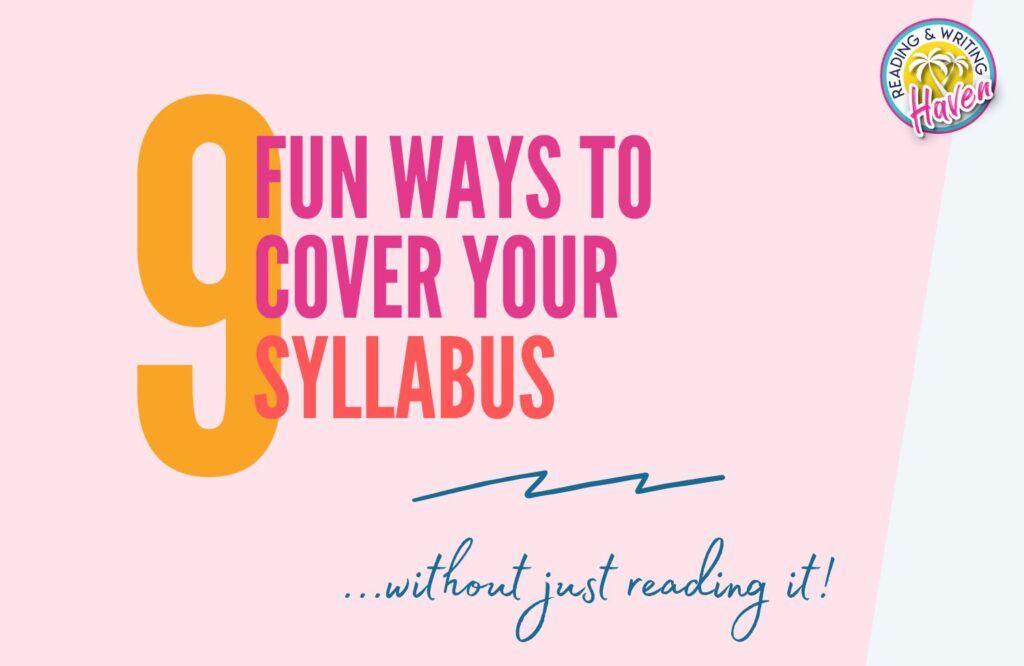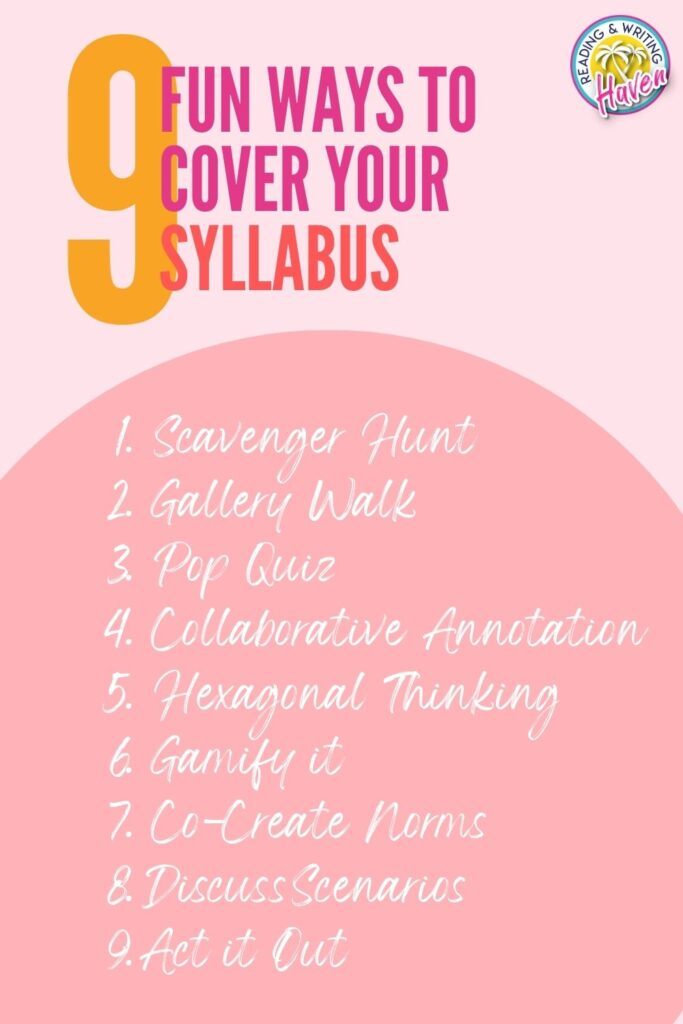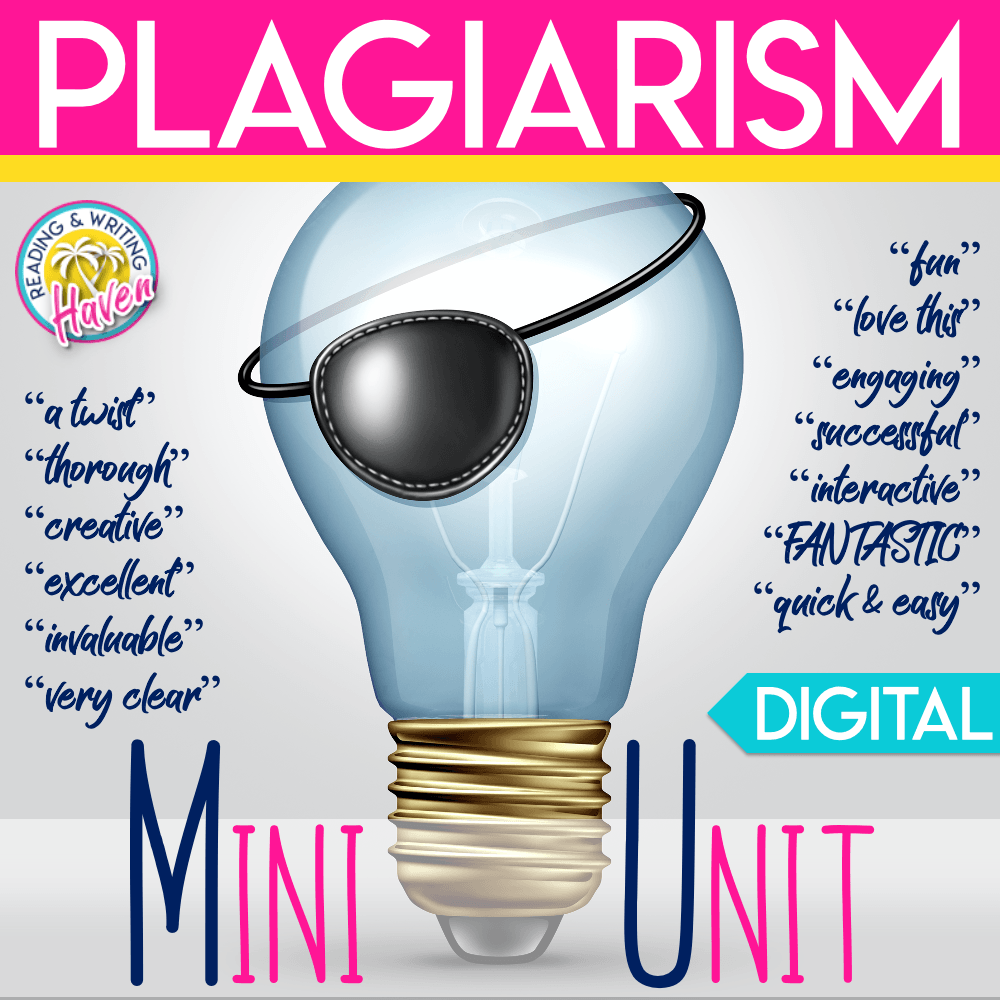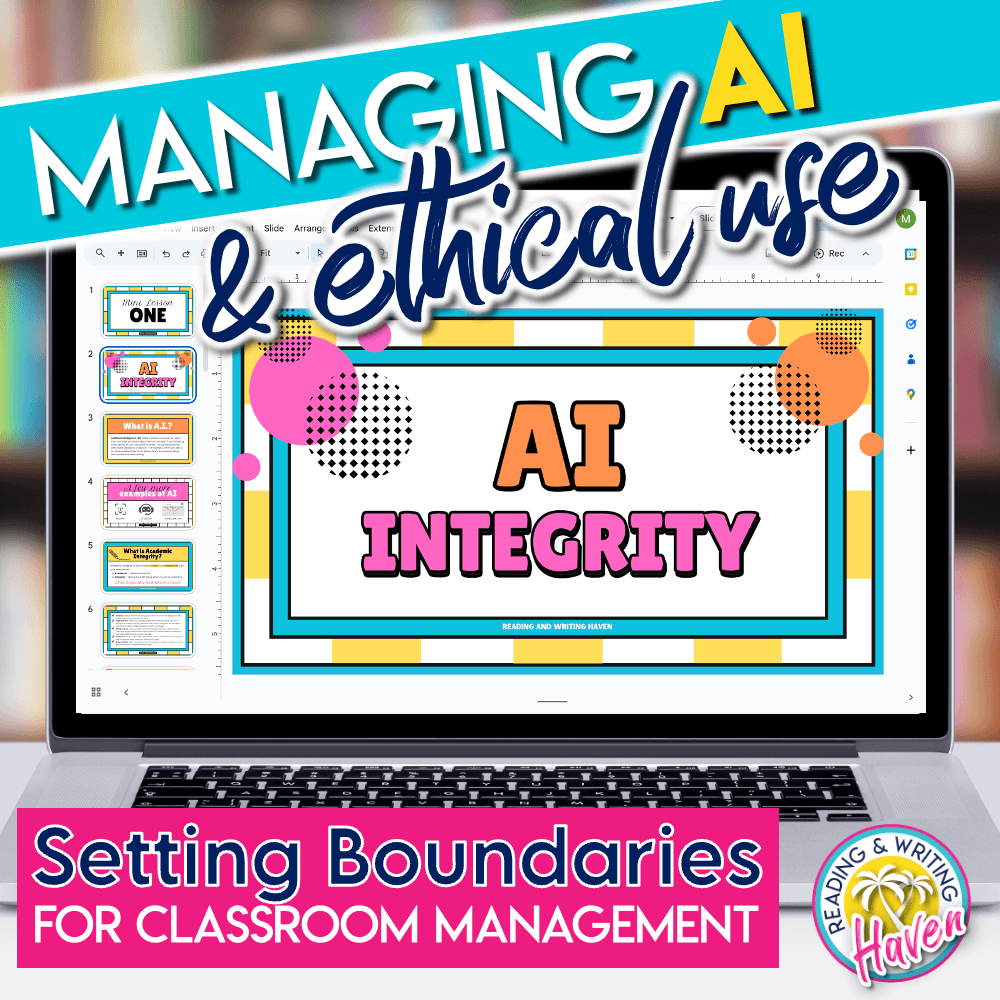9 Fun Ways to Cover Your Syllabus without Just Reading It
“Bueller? Bueller?”
Tired of the awkward silence that follows a detailed reading of your syllabus? You’re not alone. If you want students to remember and engage with your syllabus, it’s time to flip the script. Instead of passively reading it aloud, why not get students to do something with it?
In this post, I’m sharing nine fun (yes, fun—I said what I said!) strategies to cover your syllabus without putting everyone to sleep.

Idea #1: Scavenger Hunt
Turn your syllabus into an adventure! Print it out, chop it up, and post the pieces around the room like hidden treasure. Then, arm your students with a set of guiding questions and set them loose.
The questions can range from simple fact-finding (“What’s the late work policy?”) to thought-provoking (“Why do you think this rule exists?”). You can even toss in a few silly or creative ones to keep it light.
Once they’ve made their rounds, bring the class back together to share insights and tie it all together. Bonus: you’ve just tricked them into reading the syllabus and talking about it. Win-win.
Here are some example silly or creative questions you might infuse into your scavenger hunt!
- “If this section of the syllabus were a movie title, what would it be?”
- “What emoji best represents this policy? Justify your choice.”
- “Which superhero would 100% follow this rule—and which one would definitely break it?”
Idea #2: Gallery Walk
Curate a visual journey through your syllabus – mini art gallery style! Post images around the room that connect to key elements of your syllabus. For example, if you’re highlighting your retake policy, you might use a picture of a messy, squiggly path to success—because progress is rarely a straight line.
Next to each image, include a QR code that links to the related section of your syllabus. As students move through the gallery, have them scan the code, read the snippet, and jot down how they think the image connects to the policy or procedure.
Once everyone’s made the rounds, bring the class back together to unpack their interpretations. To ease into whole-group discussion, you can start with a few quick turn-and-talks.
Bonus Twist: After the gallery walk, flip the roles—now it’s their turn. Assign each student (or small group) a section of the syllabus and challenge them to create their own visual representation of a policy or procedure. It can be symbolic, literal, funny, abstract—whatever helps them connect with the content.
Once their images are ready, they can present them to the class or contribute to a student-created syllabus gallery that stays up all year. It’s a fun way to reinforce understanding and showcase creativity.
Loving the visual metaphor idea? Here are a few others to consider:
- Always bring your independent reading book: Display an image of a person sitting on a bench while others are running.
→ Everyone else is making progress (reading), but one is stuck or left out. - Be in your seat when the bell rings: Display an image of a sprinter in the starting blocks.
→ Ready to go the moment the race (or class) begins. - Where to find absent work: Display an image of a treasure map with an “X” on a computer screen.
→ The LMS is where the hidden (or not-so-hidden) info lives.
Idea #3: Pop Quiz
Pop quiz time! (But don’t worry—no pressure.) Research shows that frequent, low-stakes quizzing actually boosts memory and learning. So why not give your students a silly, open-notes syllabus quiz?
The key? Keep it ungraded, low-stress, and full of personality. Throw in one ridiculous answer for each multiple-choice question to keep students engaged and smiling. Just make one thing clear: they need to score 100%—but they can take it as many times as they need. It’s all about learning the ropes, not grading them on day one.
Example Question:
You need to do which ONE of the following to use one of your two hall passes?
a. Wait until the class discussion or lesson is completed.
b. Have your planner filled out.
c. Quietly leave the classroom.
d. Give the teacher a candy bar. 🍫
(Tempting… but no, bribery isn’t part of the policy.)
Idea #4: Collaborative Annotation
Why read the syllabus to your students when you can have them dig into it together?
Break your syllabus into chunks and assign each section to a small group (random groups = bonus community building!). If you have a large class, no problem—multiple groups can tackle the same section.
Each group reads their section together and collaborates to annotate it. That could mean underlining key points, asking clarifying questions, or even adding emojis or short reactions in the margins (👀 for surprising rules, 💡 for useful info, etc.).
Have each group choose a spokesperson to share out and a scribe to jot down the group’s ideas. After everyone’s had a chance to work through their piece, come back together and have each group teach their section to the class. Bonus: the syllabus review becomes student-led, not teacher-droned.
Loving the creative annotation idea? Here are a few approaches to consider:
Emoji Reactions
Let students use emojis to respond to parts of the syllabus:
- 💡 = “This is helpful.”
- 🤔 = “Wait, what does this mean?”
- 🚨 = “Important—don’t miss this!”
- 🙄 = “Ugh…can we reconsider this one?”
- 👏 = “Totally fair.”
- 😬 = “This might be hard for me!”
You can provide a mini “emoji legend” if you want them to be consistent across groups or let them have free rein.
Hashtag It
Encourage students to write mock hashtags next to policies:
- #ICanWorkWithThis (for grading policies)
- #BathroomBoss (hall pass rules)
- #DeadlinesAreReal
- #MissedItButMakeup
- #TheMoreYouKnow
This helps them summarize or react in a fun, Gen Z- or Gen Alpha-friendly way.
“Caption This” Challenge
Let students create captions or memes for the section they’re reading, especially for things like procedures or late work policies.
Ex: For a strict phone policy: “Me: Tries to sneak a text. Teacher: NOPE”
Highlight + Hype
Have each group highlight:
- One rule they like
- One rule they’d change or question
- One rule they think is absolutely essential
They can then explain their picks to the class.
Color Code the Chaos
Give groups colored pens or digital highlighters with meanings:
- Yellow = need clarification
- Blue = surprisingly interesting
- Green = totally agree
- Pink = confusing or controversial
“Plot Twist” Annotations
Ask them to write “plot twist” notes in the margins where something in the syllabus surprises them.
Ex: “Plot twist: You CAN turn in late work??”
Idea #5: Hexagonal Thinking
Is your syllabus more than just rules? Maybe it’s all about respect, growth mindset, or even teamwork. Challenge your students to find the theme—and then create a concept map that connects all the pieces back to it.
Or, better yet, try hexagonal thinking! Hand out hexagons with key syllabus takeaways, and have students work together to arrange them. They’ll move pieces around, spot connections, and build a visual web of how everything fits—kind of like solving a puzzle with purpose.
What might those hexagons say?
- “Respect everyone’s ideas”
- “Be ready to learn every day”
- “Late work, fewer points”
- “Two hall passes per semester”
- “Help others, ask for help”
- “Grades based on effort + mastery”
- “Phones away”
- “Growth mindset = mistakes = learning”
- “Check LMS for updates”
- “Come to class prepared”
- “Show kindness in all interactions”
Mix and match—encourage students to explain how their arrangement tells the story of your classroom culture. Bonus points for creative connections like linking “phones away” with “respect everyone’s ideas.”
Idea #6: Gamify It
Why just tell when you can play? Bring your syllabus to life with a game on Blooket, Quizlet, Gimkit, Kahoot—pick your favorite platform and let the fun begin!
Create a mix of questions that students will see again and again (because repetition is the secret sauce for memory). Include some easy ones to cover the basics—think expectations, procedures, and rules you really want to stick. Then, toss in a few curveballs: inference and application questions that get students thinking a bit deeper about why those rules matter.
Before you know it, your syllabus will be a game they actually want to play (and win)!
Want to avoid screen-style games? Try Jenga!
Screen-Free Twist: Syllabus Jenga
Grab a Jenga set (or make your own stack of wooden blocks), and write syllabus questions or prompts on each block. When a student pulls a block, they read the question or prompt aloud and answer it. Correct answers mean the block stays out (or goes on top), and the game keeps going. Wrong answers? The block goes right back.
Mix up the blocks with:
- Basic recall questions (e.g., “What’s the policy on late work?”)
- Application prompts (e.g., “Explain why we have a hall pass rule.”)
- Fun challenges (e.g., “Tell us a silly mnemonic to remember the grading scale!”)
It’s a hands-on way to review the syllabus that gets everyone moving, thinking, and laughing—no screens required.
Idea #7: Co-Create Norms
Want your students to own the rules? Reserve a special spot in your syllabus where they get to help shape the classroom expectations, procedures, and routines.
Start by modeling your own thinking—talk through how you decide what rules make sense and why they matter. Then, break students into small groups and let them brainstorm what expectations should look, sound, and feel like when the classroom is at its best.
To level up the fun:
- Give each group a different “sense” to focus on (visual, auditory, emotional)
- Use colorful sticky notes, markers, or even digital tools like Canva’s whiteboard feature
- Challenge students to come up with a catchy slogan, hashtag, or meme for each expectation
Once everyone’s shared, compile the best ideas and turn them into a Classroom Culture Manifesto. Display it proudly on your walls or your LMS—and remind students that these aren’t just rules; they’re the promises you all make to help everyone learn and thrive.
Idea #8: Scenarios
Turn those syllabus “do’s and don’ts” into stories students actually want to talk about. Pick your biggest pet peeves or the must-know moments where students’ choices really matter, and create scenarios around them.
Give students about two minutes to read your syllabus, and then introduce the scenarios! This can happen up on the screen or on task cards at tables.
Use whatever discussion style you like—think think-pair-share, small groups, or whole-class debates—but make sure to circle back and share the best takeaways so everyone’s on the same page.
Example Scenario: The bell rings, but you’re still wrapping up a quick question with the teacher. Some students start packing up early, others are chatting loudly, and it’s making it hard to focus. What’s the best way for everyone to handle the end-of-class routine so it stays calm and respectful?
Idea #9: Act it Out!
Make your class expectations come alive by creating short video clips of good and not-so-good examples—with your current students starring as the cast! It’s a fun way for students to really own the syllabus, and by the end of the year, they’ll love sharing their work with the next class.
You don’t have to go it alone—start by co-creating ideas with your students or have groups and pairs come up with their own scenes to film and submit. Then pick your favorites to show off! Bonus: it’s entertaining, memorable, and a great way to build classroom culture.
Pro Tip!
Think about the first day of school from a student’s perspective. They’re juggling nerves, new faces, and a schedule full of syllabi—and then they walk into your room. Do they get another passive read-aloud? Or do they get something that makes them think, move, and maybe even laugh?
There’s real power in teaming up with your colleagues (if you have a team) or just chatting with others who teach your students. What kind of collective experience are we giving them on those first days? Are we offering a mix of movement, collaboration, critical thinking, creativity, and yes—just enough structure to feel safe?
Let’s trade monotony for memory-making. Let’s turn “Here’s the syllabus…” into something that actually sticks. Because when the first few days set the tone, your students will walk away thinking: If this is what learning looks like here… I’m in.

Related Resources
Ready to set the tone for a new year? These resources will help you embrace hard conversations in a clear, kind, and firm way. Set the stage for predictable and consistent expectations as you discuss tough topics like AI, plagiarism, and email communication.




Love these! Wish I’d seen this post before we started back last week. I’ll definitely be saving for next year.